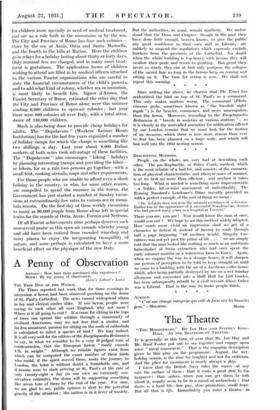DESCRIPTIVE METHODS.
People, on the whole, are very bad at describing each other. The pre-Raphaelite, or Police Court, method, which is the most reliable of a bad lot, and consists of the enumera- tion of physical characteristics and idiosyncrasies of manner, is at its best no more than efficient ; and anyhow it takes too long. What is needed is something more impressionistic —a bolder, hit-or-miss assessment of individuality. The Evening Standard's Londoner's Diary recently provided us with a perfect example of the sort of thing we mean :
" Dr. Schacht does not wear the outward semblance of a dictator. Rather has he the appearance of a successful Scandinavian dentist who had passed many years in a hospital at Toronto."
There you are, you see ! You would know the man at once, would you not Y We hope to see this method widely adopted. How much more vivid an impression shall we get of a character in fiction if, instead of having to wade through half a page beginning " Of medium height, Slingsby Car- ruthers was not yet past the prime of life . . . " we are simply told that the man looked like nothing so much as an ambitious haberdasher of Swiss extraction who had once spent the early summer months on a watercress farm in Essex. Again, when we enquire the way to a strange house, it will sharpen our powers of perception to be told to keep straight on until we come to a building with the air of a Jacbbean coffee-house which, after being partially destroyed by fire on a wet Sunday afternoon and converted into a Drill Hall for Girl Guides, has been subsequently rebuilt by a civil servant whose father was a Liberal. That is the way to make people think.






























 Previous page
Previous page